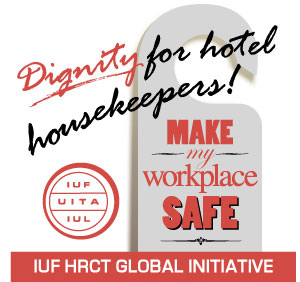
When Investors Buzz, Workers Take Cover
As the OECD released its latest Employment Outlook, which foresees a total of 57 million people without jobs in the world's 30 richest countries next year, the battle heated up over the price of a takeover of UK-based confectionery company Cadbury by Kraft, the world's second largest food corporation.
Cadbury CEO Todd Stitzer on September 22 named his price: USD 20.4 billion, up from Kraft's initial 16.7 billion. Sparring over the price, which also saw analysts speculating on a possible move by Nestlé and Hershey, set financial analysts enthusing over a "shot in the arm" for mergers and acquisitions (M&A) and "the return of M&A buzz." European food stocks surged, spurred by what Reuters called "consolidation hopes" for the food sector. Cadbury's share price leapt by 40% in morning trading the day the takeover bid was announced. More "green shoots" of recovery were detected.
What does this buzzing mean for workers? Global mergers and acquisitions hit all time highs following the 2001-2002 stock market and dot.com crashes, rising exponentially from 2004 until 2006, when they hit an astonishing USD 3.6 trillion. Food and beverages were among the most active sectors. The volume and the size of the deals rose steadily, spurred on by the massive intervention of private equity funds. Under relentless pressure to deliver "shareholder value", newly "consolidated" assets were liquidated to return cash to investors through dividends and share buybacks. Selloffs, closures and restructuring eliminated jobs, outsourcing and casualization degraded what was left - "Anyone can be replaced in 24 hours", as Nestlé CEO Brabeck recently told the press. Pension funds were wound down and closed as liabilities piled up, while investment banks and lawyers who underwrote and "advised" on the deals raked in billions.
In 2004-2006, with M&A buzzing merrily, the European food sector shed more jobs than any other sectors, including metal and textiles, with the exception of agriculture. The source of the carnage was not technology - the companies were too busy buying back their shares and raising dividends to invest significantly in new technology or productive capacity. Nor was it offshoring or trade - there was no edible equivalent of Chinese undergarments piling up on European wharves. The jobs were cut by a buzzing M&A chainsaw, as companies vied for the favor of rating agencies and investors by competing to destroy productive assets and get out the cash.
This vast transfer of wealth - funded through job destruction, greased through heavy borrowing and the accumulation of corporate debt - was implemented in the name of "growth". Kraft celebrated its return to public equity markets with a Sustainable Growth Plan which delivered 20 plant closures and 6,000 job cuts from 2000-2004. Sustainable growth continued with another 8,000 job cuts and 20 more plant closures in 2006-2008. Until the crisis knocked it off course last year, Kraft raised its dividend annually, even quarterly.
Another round of job cuts and plant closures announced in February 2008 was expected to generate another USD 1.15 billion in cost savings – all of it paid out to shareholders. It didn't really matter that Kraft management itself didn't yet know where the axe would fall: reduced headcount = greater shareholder value. Investors were pleased, so in September 2009, Kraft executives announced another 8 plants closed, eliminating 4,700 jobs.
Total compensation for CEO Irene Rosenfeld increased 50% to USD 16.9 million in 2008. When it announced the news, Kraft showed its dedication to cost savings by simultaneously announcing that it would not be producing a fancy annual report to mail out for the upcoming shareholders meeting.
The financial transformation of Cadbury (a "quintessentially British company" according to the UK Observer) came with the 2004 "Fuel for Growth" program through which the elimination of 10% of the global workforce powered cash for shareholders. In 2008, Fuel for Growth gave way to the 3-year Vision into Action, which foresees the elimination of 15% of the Cadbury workforce. Like many relative latecomers, Cadbury is currently doing better than the early starters. Unlike Kraft, which has frozen dividends and halted buybacks Cadbury continues to raise the dividend and in May initiated a new share buyback program.
The advantages of a Cadbury takeover to Kraft, now struggling under a debt burden nearly half its market capitalization, go beyond the alluring "synergies" offered by Cadbury strong brand positions in Latin America and India. The synergy is above all financial. "This is exactly what the market needs," David Thebault, head of quantitative sales trading, at Global Equities, told Reuters on September 7. "A second wind to drive stocks higher after the 50 percent relief rally, and above all, something that will put the macro stuff on the back seat."
This is precisely "the macro stuff" which has put workers in the back seat and out on the streets. When investors put out this kind of "buzz", workers have reason to fear for their jobs - and unions need to take action, at the bargaining table, in parliament, in the streets and at the G20, where it has never been on the agenda.
Financial instruments with exotic names like subprime mortgages, CDO, synthetic CDO and the like are now widely understood to have been simply sparkling names for high-risk vehicles for enriching financial investors while offloading risk. The action, vision and growth schemes which channel billions to investors through massive job cuts, casualization, the growth of non-union workplaces and the elimination of retirement benefits belong to the same financial universe. They're merely obscured by the way in which financial products are still labeled branded food products.
 Facebook
Facebook Google+
Google+ Reddit
Reddit Twitter
Twitter






